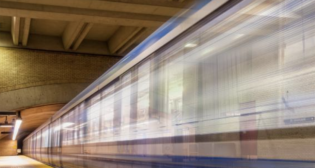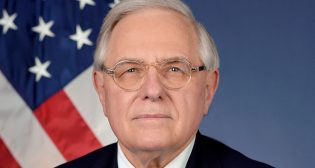
2012 PASSENGER RAIL OUTLOOK: In troubled times, still growing
Written by William C. Vantuono, Editor-in-ChiefIn long-range perspective, the story of North American passenger rail is one of extraordinary growth. The story isn’t over.
The year 2012 will see a continuation of the trend that in the last three decades has seen the number of regional/commuter systems grow from 10 to 28; the count of major rapid transit systems rise from 11 to 15; and light rail transit take off on a trajectory that has sent the number of systems from seven to 36.
All told, a nation that had 28 rail systems in 1980 had 78 in 2011.
Signs of continued growth are abundant.
A compelling one came in an updated report, “The Case for Business Investment in Public Transportation,” released in November by the American Public Transportation Association. Its major finding: Soaring demand has created a $55 billion a year public transportation industry. This includes capital investments of around $18.3 billion, of which nearly $13 billion is for rail transit. (To complete the passenger rail capital spending picture, add the hundreds of millions allocated to Amtrak for fleet acquisitions and system modernization, along with allocations from the $9 billion high speed rail program.)
A traditional measure of the strength of the passenger rail marketplace is the rate of railcar acquisitions. After a soft dip, it’s beginning to look very good. Railway Age’s exclusive annual passenger railcar survey, conducted by Managing Editor Douglas John Bowen, shows that 2012 is shaping up as one the busiest in recent memory for new railcar orders. Information supplied by the purchasing agencies discloses firm plans for ordering 749 new heavy rail (rapid transit) cars, 369 commuter/regional cars, 95 intercity cars, 66 light rail cars, and 15 streetcars. That’s nearly $3 billion worth of new business for carbuilders. Meanwhile, the Railway Age survey shows that builders entered 2012 with a backlog of 4,502 new or rebuilt passenger cars, slightly higher than the backlog a year ago and substantially higher than pre-recession levels.
Looking ahead, purchasing agencies told Railway Age they already have plans to acquire than 4,000 additional cars over the five-year 2013-2017 period.
The number of passenger transit vehicles of all types increased from 124,048 in 1998 to 172,893 in 2009. The total fleet included, on Jan. 1, 2012, 11,461 heavy rail cars, 6,941 “commuter” cars, and 2,068 light rail cars.
Costs have escalated since 2009, but in that year, rail vehicles accounted for $2.51 billion in sales: $1.65 billion for heavy rail, $455.4 million for commuter rail, and $404 million for light rail.
Federal funding helped pay for this equipment. Right now, funding levels are determined annually by continuing resolutions while Congress bickers over a new omnibus transportation spending bill. APTA recently commended Congress for passing the FY2012 appropriations bill providing $10.6 billion, a 3% increase over FY2011 (see chart above for prior years).
Although noting that “public transportation infrastructure needs exceed the appropriated funds,” APTA said: “We hope this will be a catalyst to help focus Congress on a long-term robust transportation bill. The federal Surface Transportation legislation expired more than two years ago and we are currently operating under multiple extensions. The commitment for 2012 is one important step for public transportation nationwide.”
With the funding uncertainties stemming from growing political pressure to lower taxes and to cut spending, transit agencies are scrambling for strategies keep trains running and systems growing. The biggest of them all has a strategy that so far has worked.
The New York Metropolitan Transportation Authority reduced train operations system-wide in 2011 to meet budget shortfalls. Late in the year it approved a $12.5 billion operating budget for 2012 and said a bonding program would permit MTA Capital Construction Co. to focus on multibillion-dollar expansions that will extend commuter/subway systems for the first time in 60 years.
MTA said “remarkable progress” was made in 2011 on (1) the No. 7 line West Side Extension, with structural work at the future 34th Street Station now complete; (2) the Fulton Street Transit Center, now more than 50% complete; (3) the Second Avenue Subway, with tunneling for the project’s first phase now cfinished; and (4) the East Side Access project, the first expansion of the LIRR in more than 100 years, and the largest transportation project in the country. Now half way to completion, it will give LIRR riders direct access to Grand Central Terminal on Manhattan’s East Side as well as to Penn Station on the West Side.
Intercity
A “high speed initiative” billed as the story of the century—many call it ObamaRail—turned out to be less than advertised, but more than most critics have been ready to acknowledge. The only surviving state initiative that meets international standards of speeds in the neighborhood of 200 mph is California’s plan for a 700-mile statewide HSR system linking San Diego and Los Angeles in the south with twin branches to both the Bay Area and Sacramento, the state capital. The estimated cost has risen from an initial $44 billion to a revised $98.5 billion. Washington has pledged more than $3 billion to the project, and the state is offering an initial $11 billion through bonds. Gov. Jerry Brown is an enthusiastic supporter of the plan, though it has an army of critics. The strategy is to build an initial section of line in the Central Valley between the end points; making ends meet could be a challenge.
As of Jan. 1, 2012, the U.S. Department of Transportation had allocated $9,238,552,394 for 145 high (or higher-) speed projects in 27 states. All but the California grant have gone to projects throughout the country to raise speeds on existing lines, an objective few are ready to quarrel with.
Amtrak, perennially short of capital funding, scented an opportunity and came up with a 30-year, $117 billion “vision” to bring 220 mph service to its Northeast Corridor. Amtrak and states in the region have received $954 million from the high-speed program to date to improve existing infrastructure. Amtrak’s $1.42 billion in funding from Congress for this fiscal year was short of a requested $2.22 billion that included plans to buy 40 more Acela Express cars to increase trainset lengths on its well-patronized premium Northeast Corridor service.
Even if its HSR vision turns out to be blurred, Amtrak has a better story than many are ready to listen to. Persistently regarded by right-wing think tanks as a failure (because it doesn’t mint profits—a fault shared by every major intercity passenger rail system in the world), Amtrak carried more passengers in FY2011, 30.2 million, than ever before in its history, and its eighth record in nine years. With business at record levels, Amtrak has capacity issues and has 70 electric locomotives and 120 single-level cars on order. Amtrak President Joe Boardman hopes to order the 40 new Acela Express cars this year, Congress willing.
New equipment will help improve Amtrak’s ontime performance, but equipment alone can’t solve the problem. In a 30-day period toward the end of 2011, 1,225 trains were operated; only 619 (51%) were on time. It is a point of contention as to how much of this Amtrak can fix and how much is derived from the host freight railroads’ impatience with anything that gets in the way of their freight trains.



